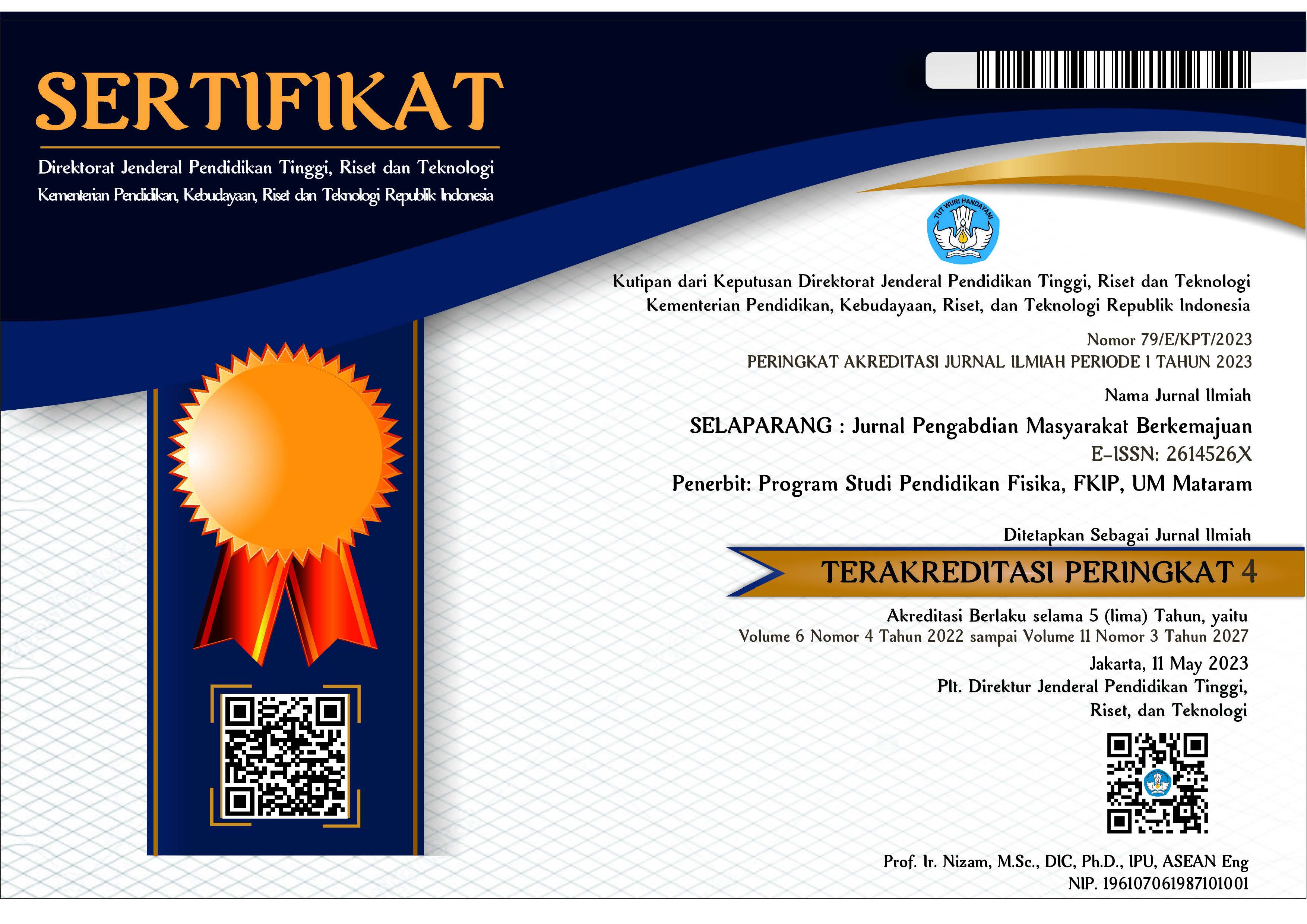TEKNOLOGI BIOREMEDIASI MENGGUNAKAN Trichoderma sp. DALAM RANGKA MENINGKATKAN PRODUKTIVITAS PERTANIAN PADA LAHAN BEKAS TAMBANG PASIR DI DESA MRAWAN-JEMBER
Abstract
ABSTRAK
Desa Mrawan yang terletak di Kecamatan Mayang, Kabupaten Jember memiliki lahan pertanian mencapai ± 1.145 ha yang menjadi salah satu desa penopang ketahanan pangan. Potensi pertanian di Desa Mrawan cukup besar dengan komoditas tanaman yang dibudidayakan meliputi tanaman padi, jagung, dan kacang-kacangan. Hasil produktivitas tanaman budidaya di Kabupaten Jember mencapai 6-8 ton per ha, akan tetapi di Desa Mrawan rata-rata hanya mencapai 3,5 sampai dengan 4 ton per ha. Adapun permasalahan disebabkan oleh degradasi lahan yang mengakibatkan rusaknya struktur fisik, kimia dan biologi tanah. Selain itu permasalahan lainnya yaitu serangan hama dan penyakit pada tanaman budidaya. Berdasarkan permasalahan tersebut dilakukan penyuluhan mengenai bioremediasi lahan menggunakan bahan organik yang dikombinasikan dengan Trichoderma sp sebagai agens bioremediasi. Metode yang digunakan meliputi seminar, ceramah, dan praktik. Hasil kegiatan ini adalah petani memiliki keterampilan dalam produksi pupuk organik dan teknologi bioremediasi.
Kata kunci: bioremediasi; penyuluhan; Trichoderma sp
ABSTRACT
The village of Mrawan, situated in Mayang Sub-district, Jember Regency, boasts an agricultural expanse of roughly 1145 ha, thus serving as one of the key villages supporting food security. The agricultural potential of Mrawan Village is notably vast, encompassing a range of crops such as rice, corn, and legumes. While the productivity of cultivated crops in Jember Regency amounts to 6-8 tons per ha, Mrawan Village's yield is merely an average of 3.5 to 4 tons per ha, largely due to land degradation that has led to the physical, chemical, and biological degradation of the soil structure. Furthermore, pest attacks and crop diseases pose additional challenges. Consequently, to address these concerns, education on land bioremediation utilizing organic materials in conjunction with Trichoderma sp as a bioremediation agent was conducted through a range of methods including seminars, lectures, and practical exercises. As a result of this initiative, farmers have gained competencies in the production of organic fertilizers and bioremediation technology.
Keywords: bioremediation; extension; Trichoderma sp.
Keywords
Full Text:
PDFReferences
Abatenh E., Gizaw B., Tsegaye Z., Wassie M. 2017. The role of microorganisms in bioremediation-A review. Open Journal of Environmental Biology. 2(1):038-046.
Abdel-lateif K. S. 2017. Trichoderma as biological control weapon against soil borne plant pathogens. African Journal of Biotechnology. 16(50):2299-2306.
Abdollahzadeh G., Sharifzadeh M. S., Damalas C. A. 2015. Perceptions of the beneficial and harmful effects of pesticides among Iranian rice farmers influence the adoption of biological control. Crop Protection. 75:124-131.
Adams G. O., Fufeyin P. T., Okoro S. E., Ehinomen I. 2015. Bioremediation, biostimulation and bioaugmention: a review. International Journal of Environmental Bioremediation & Biodegradation. 3(1):28-39.
Adnan N., Nordin S. M., Bahruddin M. A., Tareq A. H. 2019. A state-of-the-art review on facilitating sustainable agriculture through green fertilizer technology adoption: Assessing farmers behavior. Trends in Food Science & Technology. 86:439-452.
Bagheri A., Emami N., Damalas C. A., Allahyari M. S. 2019. Farmers’ knowledge, attitudes, and perceptions of pesticide use in apple farms of northern Iran: impact on safety behavior. Environmental Science and Pollution Research. 26:9343-9351.
Barbier E. B., Hochard J. P. 2018. Land degradation and poverty. Nature Sustainability. 1(11):623-631.
Damalas C. A., Koutroubas S. D. 2018. Farmers' behaviour in pesticide use: A key concept for improving environmental safety. Current Opinion in Environmental Science & Health. 4:27-30.
Gibbs H., Salmon J. M. 2015. Mapping the world's degraded lands. Applied geography. 57:12-21.
Gomiero T. 2016. Soil degradation, land scarcity and food security: Reviewing a complex challenge. Sustainability. 8(3):281.
Kashyap P. L., Rai P., Srivastava A. K., Kumar S. 2017. Trichoderma for climate resilient agriculture. World Journal of Microbiology and Biotechnology. 33:1-18.
Olowe O. M., Nicola L., Asemoloye M. D., Akanmu A. O., Babalola O. O. 2022. Trichoderma: Potential bio-resource for the management of tomato root rot diseases in Africa. Microbiological Research.126978.
Rachman A. 2017. Peluang dan tantangan implementasi model pertanian konservasi di lahan kering. Sumber Daya Lahan. 11(2):77-90.
Rai N., Limbu A. K., Joshi A. 2020. Impact of Trichoderma sp. in agriculture: A mini-review. Journal of Biology and Today's World. 9(7):1-5.
Sharma B., Dangi A. K., Shukla P. 2018. Contemporary enzyme based technologies for bioremediation: a review. Journal of environmental management. 210:10-22.
Sharma M., Reynnells R. 2018. Importance of soil amendments: survival of bacterial pathogens in manure and compost used as organic fertilizers. Preharvest food safety.159-175.
Singh A., Shukla N., Kabadwal B., Tewari A., Kumar J. 2018. Review on plant-Trichoderma-pathogen interaction. International Journal of Current Microbiology and Applied Sciences. 7(2):2382-2397.
Sittadewi E. H. 2016. Mitigasi lahan terdegradasi akibat penambangan melalui revegetasi. Jurnal Sains dan Teknologi Mitigasi Bencana. 11(2):50-60.
Sood M., Kapoor D., Kumar V., Sheteiwy M. S., Ramakrishnan M., Landi M., Araniti F., Sharma A. 2020. Trichoderma: The “secrets” of a multitalented biocontrol agent. Plants. 9(6):762.
Suvedi M., Ghimire R., Kaplowitz M. 2017. Farmers’ participation in extension programs and technology adoption in rural Nepal: a logistic regression analysis. The Journal of Agricultural Education and Extension. 23(4):351-371.
Vinale F., Sivasithamparam K. 2020. Beneficial effects of Trichoderma secondary metabolites on crops. Phytotherapy Research. 34(11):2835-2842.
Xie H., Zhang Y., Wu Z., Lv T. 2020. A bibliometric analysis on land degradation: Current status, development, and future directions. Land. 9(1):28.
DOI: https://doi.org/10.31764/jpmb.v7i2.14144
Refbacks
- There are currently no refbacks.

This work is licensed under a Creative Commons Attribution-ShareAlike 4.0 International License.
______________________________________________________
Jurnal Selaparang
p-ISSN 2614-5251 || e-ISSN 2614-526X
EDITORIAL OFFICE:



















